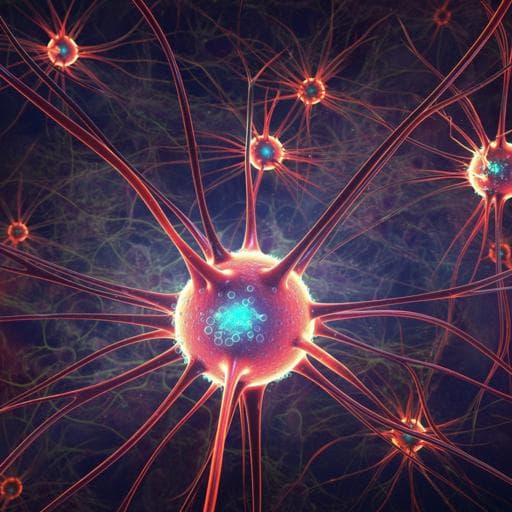
Medicine and Health
Use of physiologically based kinetic modeling to predict neurotoxicity and genotoxicity of methylglyoxal in humans
L. Zheng, X. Li, et al.
This study by Liang Zheng, Xiyu Li, Frances Widjaja, Chen Liu, and Ivonne M. C. M. Rietjens explores the neurotoxicity and genotoxicity risks associated with methylglyoxal (MGO). Using advanced PBK modeling and reverse dosimetry, the research reveals intriguing insights about dietary and endogenous MGO intake, emphasizing the importance of risk assessment in different populations.
~3 min • Beginner • English
Introduction
Methylglyoxal (MGO) is a highly reactive α-oxoaldehyde present in many foods and beverages and also formed endogenously, primarily as a by-product of glycolysis. Physiological detoxification occurs mainly via the glutathione-dependent glyoxalase system (Glo1/Glo2), maintaining low plasma and cellular MGO levels. Pathophysiological conditions such as hyperglycemia can elevate in vivo MGO, with type 2 diabetics showing up to ~30% higher plasma levels than healthy individuals. MGO is a potent precursor of advanced glycation end products (AGEs), implicated in chronic diseases including diabetes and neurodegeneration. Clinical observations link higher serum MGO to accelerated cognitive decline; increased MGO/AGEs have been reported in CSF of Alzheimer’s patients and in nigral neurons of Parkinson’s patients. In vitro, exogenous MGO induces neuronal toxicity (reduced viability and mitochondrial function, increased ROS and apoptosis). MGO also shows genotoxic potential via DNA adduct formation (e.g., N-(1-carboxyethyl)-2'-deoxyguanosine, CEdG) and mutagenesis. However, in vitro concentration–response data require translation to in vivo dose–response for human risk assessment. This study applies PBK modeling-facilitated reverse dosimetry (QIVIVE) to translate in vitro neurotoxicity and genotoxicity data into predicted human in vivo dose–response and to assess risk from dietary and endogenous MGO via the MOE approach.
Literature Review
Evidence links elevated MGO and AGEs to neurodegenerative processes: higher serum MGO correlates with cognitive decline; elevated MGO/AGEs occur in Alzheimer’s CSF and Parkinson’s nigral neurons. Neuronal cells are particularly susceptible to MGO, potentially due to high glucose metabolism, lower glutathione, and lower glyoxalase activity compared with astrocytes. In vitro studies across human neuronal models (SH-SY5Y, SK-N-MC, SK-N-SH, hNLCs) show decreased mitochondrial activity/viability and increased ROS and apoptosis upon MGO exposure. Genotoxicity evidence includes increased mutation rates and formation of MGO-derived DNA adducts such as N2-(1-carboxyethyl)-dG (CEdG) in human cells, with endogenous lesion rates ~1 per 10^7 nucleosides and concentration-dependent increases with exogenous MGO. These data motivate quantitative translation to in vivo exposure metrics for risk assessment.
Methodology
The study used PBK modeling-facilitated reverse dosimetry (QIVIVE) to predict human in vivo dose–response from in vitro data for MGO neurotoxicity and genotoxicity. Steps: (1) Develop a mouse PBK model for MGO kinetics; (2) Evaluate against literature blood concentration–time data in mice (single oral doses 50, 100, 200 mg/kg bw); (3) Define a human PBK model from the evaluated mouse model; (4) Use the human PBK model to translate in vitro concentration–response data (human neuronal-like cells [hNLCs] and WM-266-4 cells) to in vivo dose–response; (5) Conduct risk assessment via MOE using predicted points of departure (PODs). Mouse PBK model: compartments for stomach, intestine (7 serial sub-compartments), liver, fat, blood, rapidly and slowly perfused tissues; first-order processes for GI transport, absorption, clearance. Intestinal absorption defined using an apparent permeability (Papp) from Caco-2 (1.09×10^−6 cm/s), scaled to in vivo human using log-linear correlation and to mouse by division by 3.6; absorption rate = Papp,in vivo × intestinal surface area × luminal concentration. A 55 min lag time was included to match observed delay in rising blood MGO after oral dosing. Tissue:blood partition coefficients were estimated via Rodgers and Rowland method using LogP=0.196 and MW=72.06 g/mol; blood-to-plasma ratio assumed 1. Metabolism/elimination modeled as apparent total body clearance (CLapp) apportioned to tissues by volume fraction, reflecting ubiquitous glyoxalase activity. Literature CLapp values (mice) were 7.69, 8.28, 15.54 L/h/kg at 50, 100, 200 mg/kg; due to likely saturation/limited uptake at higher doses, the lowest CLapp (7.69 L/h/kg) was used as default, with fraction absorbed (fa) correction applied at high doses to fit data. Numerical integration used Berkeley Madonna (Rosenbrock). Model performance was assessed by comparing predicted and reported Cmax and Tmax; sensitivity analysis (±5% parameter change) identified influential parameters on Cmax (SAin, Vin, ksto, Papp, kin, CLapp, flows/volumes). Human PBK model: physiological parameters from literature; Papp,in vivo determined as above; human CLapp assumed equal to mouse (7.69 L/h/kg) based on conserved glyoxalase physiology and comparable Glo1 activity; no lag phase included (irrelevant for Cmax-based QIVIVE). Reverse dosimetry: In vivo dose required to reach effective unbound Cmax equal to in vitro unbound concentration was predicted. Unbound correction: Cin vivo × fub,in vivo = Cin vitro × fub,in vitro, with fub,in vivo = 0.71 (QIVIVE tool) and fub,in vitro derived assuming linear dependence on protein content (serum-free medium → fub,in vitro ≈ 1). For very high predicted oral doses (>200 mg/kg bw) a human fa correction of 0.45 was applied based on mouse model fitting at high doses. In vitro datasets: hNLCs for mitochondrial function (MTT), cytotoxicity (Trypan Blue), apoptosis (Hoechst 33258); WM-266-4 cells for R- and S-N2-CEdG DNA adduct formation (3 h). Benchmark dose modeling: US EPA BMDS 3.2 with exponential/hill models for continuous data; PODs taken as BMDL10; both BMDL10 and BMDU10 reported for visualization. MOE calculation: MOE = POD (BMDL10)/exposure. Exposures considered: dietary intake (worst-case 0.29 mg/kg bw/day) and endogenous formation (healthy 3.09 mg/kg bw/day; diabetic worst-case 12.35 mg/kg bw/day). Health-concern thresholds: MOE ≥100 for neurotoxicity endpoints (10 for interindividual variability × 10 for NAMs); MOE ≥10,000 for DNA adduct formation (10 interindividual × 10 NAMs × 10 carcinogenic process uncertainties × 10 due to using BMDL10).
Key Findings
- Mouse PBK model evaluation: Predicted blood MGO time-courses matched in vivo mouse data within two-fold across 50–200 mg/kg bw doses. Using CLapp=7.69 L/h/kg for higher doses overpredicted Cmax by 1.05× (100 mg/kg) and 2.02× (200 mg/kg); applying fa=0.45 at 200 mg/kg improved fit (predicted Cmax 1.02× reported). Sensitivity analysis identified GI transport/absorption parameters (SAin, Vin, ksto, Papp, kin) and CLapp as most influential on Cmax.
- In vitro potency overview (hNLCs): Cytotoxicity EC50 220.8 µM (48 h), mitochondrial function EC50 298.3–340.5 µM (24–48 h); apoptosis observed from ~10 µM upward (no robust EC50). DNA adducts (WM-266-4): concentration-dependent R- and S-N2-CEdG formation over 0–1250 µM (3 h).
- Predicted human in vivo BMDL10 values (PODs):
• Mitochondrial function: 1327 mg/kg (24 h), 1366 mg/kg (48 h)
• Cytotoxicity: 739 mg/kg (24 h), 590 mg/kg (48 h)
• Apoptosis: 1233 mg/kg (24 h), 304 mg/kg (48 h)
• DNA adducts: R-N2-CEdG 251 mg/kg; S-N2-CEdG 254 mg/kg
- MOEs for dietary MGO (0.29 mg/kg bw/day):
• Neurotoxicity endpoints: 1047–4711 (all ≥100, indicating low concern)
• DNA adducts: 866–876 (≪10,000; concern cannot be excluded)
- MOEs for endogenous MGO (healthy 3.09 mg/kg bw/day):
• Neurotoxicity: mitochondrial 429–442 (≥100), cytotoxicity 191–239 (≥100), apoptosis (48 h) 98 (<100; potential concern)
• DNA adducts: 81–82 (<10,000; concern cannot be excluded)
- MOEs for endogenous MGO (diabetic 12.35 mg/kg bw/day):
• Neurotoxicity: mitochondrial 107–111 (borderline ≥100), cytotoxicity 48–60 (<100), apoptosis (48 h) 25 (<100) indicating concern
• DNA adducts: 20–21 (≪10,000) indicating concern
- Estimated daily endogenous formation (~3.09 mg/kg) exceeds dietary intake (~0.07–0.29 mg/kg) by >10-fold; PBK simulations indicate internal Cmax from dietary intake are >3-fold lower than endogenous plasma MGO (~0.29 µM).
Discussion
The PBK-QIVIVE approach enabled translation of in vitro neuronal toxicity and DNA adduct formation caused by MGO into quantitative human in vivo dose–response. Applying MOE-based benchmarks (≥100 for neurotoxicity; ≥10,000 for DNA adducts), daily dietary intake of MGO is unlikely to elicit mitochondrial dysfunction, cytotoxicity, or apoptosis in neurons. However, both dietary and endogenous exposures yield MOEs far below 10,000 for DNA adduct formation, implying that genotoxic concerns cannot be excluded, with greater concern for diabetics because of higher endogenous formation. Endogenous MGO formation is the dominant contributor to systemic exposure compared to dietary intake. The analysis adopts conservative uncertainty factors analogous to EFSA’s acrylamide assessment, explicitly including an uncertainty factor for NAMs. The PBK models suggest GI absorption and systemic clearance are key determinants of internal Cmax. The use of blood Cmax as a driver for neurotoxicity is a pragmatic choice given limited data on CNS penetration; if CNS transport is restricted, neurotoxicity MOEs for dietary exposure would be even larger (less concern). The findings underscore the need to consider endogenous formation in MGO risk assessment and to prioritize susceptible populations (e.g., diabetics).
Conclusion
This study provides a proof of principle integrating in vitro neurotoxicity and genotoxicity data with human PBK modeling and reverse dosimetry to predict in vivo dose–response for methylglyoxal. Predicted MOEs indicate that dietary MGO intake is unlikely to pose neurotoxicity risks at evaluated endpoints, but potential genotoxic risk (DNA adduct formation) cannot be excluded for both dietary and endogenous exposures. Elevated endogenous formation, particularly in diabetics, may pose risks for both genotoxicity and certain neurotoxicity endpoints (apoptosis, cytotoxicity). The work emphasizes incorporating endogenous MGO levels in risk assessment and demonstrates the utility of PBK-QIVIVE NAMs. Future research should refine clearance parameters via independent in vitro data, include population variability (e.g., Monte Carlo), incorporate CNS compartments and tissue-specific endogenous formation, use more physiologically relevant genotoxicity models (e.g., human lymphocytes with longer exposures), and assess combined risks from other dicarbonyls (glyoxal, 3-deoxyglucosone).
Limitations
- Limited in vivo kinetic datasets for model evaluation; clearance parameters (CLapp) originate from fits to the same study used for evaluation (Ghosh et al.), potentially biasing performance.
- Assumed identical CLapp in humans and mice based on glyoxalase conservation; cross-species detoxification capacity differences were not empirically verified here.
- Human PBK model lacks an explicit CNS compartment; neurotoxicity predictions used blood Cmax as surrogate for CNS exposure.
- High-dose fa correction (fa=0.45) applied for doses >200 mg/kg introduces additional uncertainty; in vitro datasets included concentrations far above realistic dietary exposures.
- Genotoxicity QIVIVE relied on WM-266-4 melanoma cells with 3-h exposure; tumor cell metabolism and short exposure may not represent normal human cells or chronic genotoxic processes.
- Uncertainty factors for NAMs (10) and interindividual variability adopted by default; actual variability in key parameters (GI absorption, clearance) not propagated; no Monte Carlo analysis performed.
- Endogenous formation rates were treated as systemic estimates; tissue-specific formation/detoxification heterogeneity was not modeled.
Related Publications
Explore these studies to deepen your understanding of the subject.







